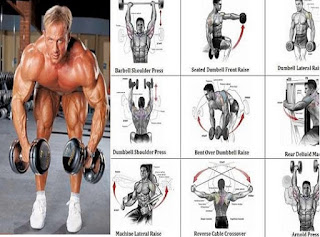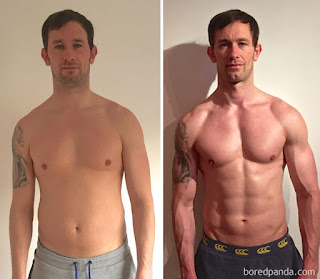What are the best exercises for the lower chest?
People who want to improve their lower chest muscles should try a variety of pectoral muscle strengthening exercises.
The pectoral muscles, also known as the pecs, are the muscles that characterize the shape and appearance of the chest. They also control a variety of arm movements, such as flexing, spinning, and moving the arm in toward the body's midline (adduction).
The pecs are made up of two muscles. The pectoralis major runs from the shoulder to the center of the chest, while the pectoralis minor runs along the chest's outer edge, just behind the pectoralis major.
People can do exercises that work the entire chest region to build up their pecs. Using adapted lifts, it is possible to target particular regions of the chest.
People should engage in muscle-strengthening activities at least twice a week, according to the Physical Activity Guidelines for Americans. In resistance training, one set of 8 to 12 repetitions (reps) is effective, but two or three sets may be more effective.
This article outlines five exercises that can be used to increase lower chest strength and definition.
1. Pushups with a slant
Because they work the entire upper body and back, pushups are a superb multifunctional exercise. Pushups performed on an incline will focus more on the lower chest.
What you'll Need:
A flat workout bench, a jump box, or a step platform are all good options.
Steps to take:
* Place yourself in front of the bench. Place your hands on the bench's edge, shoulder-width apart.
* Extend the legs backwards until the legs and back form a straight line. Maintain your weight on the balls of your feet.
* Slowly lower the chest toward the bench by bending the wrists. Always keep your elbows and wrists close to your body.
* Extend the arms while keeping a slight bend in the elbow as you slowly push your body away from the bench.
* One set can consist of 8–12 reps.
2. Reduce the number of reps you do with the dumbbell press.
This exercise is designed to be done with dumbbells, but it can also be done with a barbell.
People can lift heavier weights for fewer reps with a barbell, but dumbbells provide a higher range of motion, making them a better choice for people who want to target their lower chest.
What you'll Need:
one decline bench with two dumbbells or one barbell
Steps to take:
* Place one dumbbell in each hand and lie down on the decline bench at a 45-degree angle. With the palms facing inward, rest the dumbbells on the legs. It's important to remember to keep your back flat.
* Raise the dumbbells to your chest and stretch your arms to the ceiling.Hands should be facing inward with palms facing inward.
* Rotate the wrists until the palms are facing away while holding the dumbbells shoulder-width apart.
* Begin by bending your wrists into a 90-degree angle at the elbow. The dumbbells should be placed on the chest's outer edges.
* Inhale deeply.
* Push the dumbbells up with your upper muscles as you exhale. Hold the squeeze for 1–2 seconds at the top of the lift.
* Return to the starting position by slowly lowering the dumbbells.
* One set can consist of 8–12 reps. Between sets, take a break.
3. External rotating dumbbell bench press with a decline
This exercise is a variant of the previous one. Because it's a little more complicated than a conventional dumbbell press, beginners should start with lighter weights until they're comfortable with the movement.
What you'll Need:
one decline bench with two dumbbells or one barbell
Steps to take:
With one dumbbell in each hand, lie down on the decline bench. With the palms facing inward, rest the dumbbells on the legs.
Raise the dumbbells to your chest, arms pointed toward the ceiling, and hands in the same position as before.
* Return to the starting position with the dumbbells, but this time keep the palms facing inward. The palms should not be rotated.
* Parallel to the body, the dumbbells to be held.
* Slowly inhale.
* On the exhale, press the dumbbells up with the chest muscles while rotating the palms outward * to make the thumbs face each other. Hold the squeeze for 1–2 seconds.
* Slowly lower the dumbbells while rotating the palms inward to return to the starting position.
* 8–12 reps per set are recommended. Between sets, take a break.
4. Crossover cable
Depending on the position of the pulleys, cable machines provide a variety of exercise options. Setting the pulleys higher will focus on the lower chest, while setting them lower will focus on the upper chest.
The cable crossover strengthens the muscles in the lower and upper chest.
What you'll Need:
a cable splicer
Steps to take:
* Place the pulleys above your head. Select the desired weight by attaching one handle to each pulley.
* With the palms facing down, take one handle in each hand. To add a little tension on the wires, * stand in the middle of the cable machine and take a few steps forward.
* Take a step forward.
* Extend your arms to the side while maintaining a slight bend in your elbows. Allow no movement of the elbows behind the shoulders.
* Bring your hands together in front of your body as you exhale.
* Slowly stretch the arms and inhale to return to the starting position.
* Reps should be 8–12 per set, with rest in between.
5. Dips with parallel bars (chest)
Dips with parallel bars work a variety of muscle groups in the chest, arms, shoulders, and back. Remember to lean slightly forward on the dip to engage the muscles in the lower chest during this exercise.
What you'll Need:
a set of bars that are parallel to one another
Steps to take:
* Grip the bars and squeeze your body up above them with your wrists.
* Inhale slowly while bending your arms and leaning forward in your torso. Lower your body until you feel a mild stretching sensation in your chest.
* Raise your body above the bars on the exhale.
* Rep as many times as you can without overworking your muscles.
Dips with parallel bars require a lot of upper-body strength. Those who are unsure about performing a full chest dip should try the variation below instead.
Dip variation with parallel bars:
* Grip the bars and jump up to the point where your arms are straight and your body is above them.
* Bending the arms and leaning forward, slowly lower yourself. Continue until you feel a mild stretching in your chest.
* Place the feet on the floor and let go of the bars instead of pulling the body back up.
* Rep as many times as you can without overworking your muscles. Before attempting a complete chest dip, focus on increasing upper-body strength and extending range of motion.
In conclusion
When performed properly, the exercises above will strengthen the lower chest. To achieve a well-balanced physique, combine these exercises with a full-body strength training regimen.
Individuals attempting these exercises should keep in mind that proper form and technique are required for each movement. People can prevent injuries by not rushing through sets and not using excessively heavy weights. Because muscles need time to recover after a hard workout, it's important to avoid training the same muscle groups on consecutive days.









Commentaires
Enregistrer un commentaire